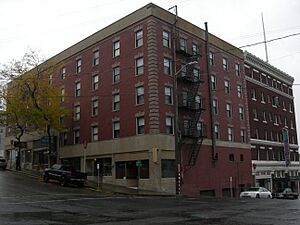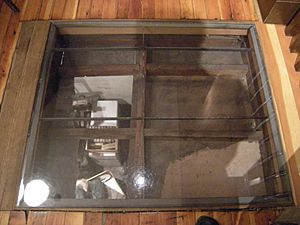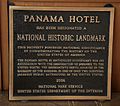Panama Hotel (Seattle) facts for kids
|
Panama Hotel
|
|

Coffeehouse in the old lobby of the Panama Hotel
|
|
| Location | 605 S. Main St Seattle, Washington |
|---|---|
| NRHP reference No. | 06000462 |
Quick facts for kids Significant dates |
|
| Added to NRHP | March 20, 2006 |
| Designated NHL | March 20, 2006 |
The Panama Hotel in Seattle, Washington's International District was built in 1910. It was designed by Sabro Ozasa, the first Japanese-American architect in Seattle. This special hotel is home to the last traditional Japanese bathhouse, called a sento, still left in the United States.
The Panama Hotel was a very important place for the Japanese community. It had businesses, a bathhouse, rooms for people to stay, and restaurants. Since 1985, Jan Johnson has owned the hotel. She is the third owner and has worked hard to make the building look like it did before World War II.
During that time, many Japanese Americans were forced to leave their homes. They had to go to special camps. Jan Johnson has kept the basement of the hotel closed to the public. This basement holds many belongings that Japanese families left behind. Visitors can see these items through a glass panel in the floor.
The Panama Hotel is famous for its rich Japanese American history, especially during World War II. It became a storage place for the belongings of Japanese families in Seattle. This happened after Executive Order 9066 was put into action. This order forced Japanese Americans into internment camps. After the Japanese American internment, many families could not return to Seattle. This was due to financial problems, moving away, or even death. Their belongings are still kept safely in the hotel's basement today.
The hotel is also known because it inspired the novel Hotel on the Corner of Bitter and Sweet by Jamie Ford.
On December 1, 2020, the Panama Hotel received a special award. It was given the Japanese Foreign Minister’s Commendation. This award recognized its efforts to help Japan and the United States understand each other better.
Contents
Seattle's "Japantown" (Nihonmachi)
In the early 1900s, different neighborhoods were created in Seattle's International District. These areas were often based on people's race or background. Seattle's "Japantown," also known as Nihonmachi, was one of these places. It helped Japanese immigrants connect and form strong cultural bonds.
Japanese immigrants came to Seattle from all over Japan. They became a close community because of the Nihonmachi. Even though people in Japantown faced tough times, skilled workers from many different parts of Japan came together.
Japanese Bathhouses (Sento)
Before World War II, the Panama Hotel was a central spot in Japantown. It was famous for the Hashidate-Yu. This was one of only four public bathhouses, or Sento, in Seattle during the early 1900s. These bathhouses had separate areas for men and for women and children.
They were very important in Japantown. This is because most people living there did not have bathrooms in their own homes. The bathhouses were also places where people could meet, talk, and share their culture. Locals and visitors from other countries would come together there.
A National Treasure
In 2006, the Panama Hotel was named a National Historic Landmark. This means it is a very important historical building. Then, on April 9, 2015, it was given an even higher honor. The National Trust For Historic Preservation named the Panama Hotel a National Treasure. It is one of only 60 such treasures in the entire United States.
The Panama Hotel Film
A movie called "The Panama Hotel Legacy" is being made right now. This film will tell the amazing story of the hotel, which is over 105 years old. It will show how people have worked to keep its history alive. The movie aims to teach both current and future generations about this special place.
The film will explore how the building has influenced its location, culture, and community. It will also show the efforts to protect the Panama Hotel. This includes the Hashidate Yu Sento, which is one of the best-preserved bathhouses in the U.S. The movie will also cover the archiving of Japanese Americans' belongings. These items were stored in the hotel after President Roosevelt issued Executive Order 9066 in 1942.
- The official website for The Panama Hotel Legacy Film Project has a preview of the movie.
Images for kids










